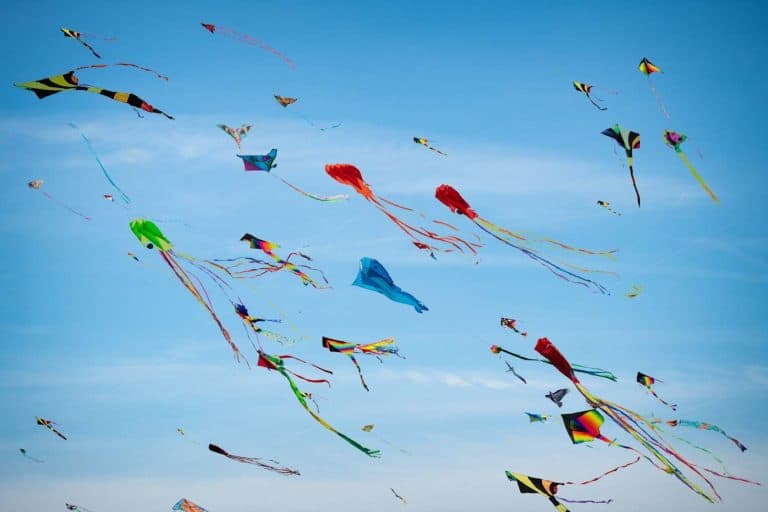4 Signs it’s Time to Replace Your Kite Lines
Like any other equipment, kite lines need to be correctly cared for and maintained for longevity. This article discusses things that tell you it’s time to replace your kite lines.
Factors that affect kite line integrity include chemicals, U.V rays, repeated use, and wear. When the lines are misused, they may lead to property or personal injury. Therefore, inspecting them for damage is necessary.
4 Reasons To Replace Kite Lines
1. Knots On Kite Lines
Finding knots on kites is common for kite flyers. You may notice these knots when you’re out in the water or preparing your equipment. Whenever you see knots on the kite, you should prioritize untangling them.
Most kite lines are designed to handle heavy loads before they break. The weight ranges from 200kg to 350 kg.
Keep in mind that front lines have a higher load than back lines. Therefore, knots can cause kites to be insecure and compromise on kite fliers’ safety. It is mainly because a single knot reduces the strength of the kite line by about 50% (2).
The worst-case scenario may require you to self-rescue. If the front lines have knots, the kite may fall into the water. However, if the back lines are affected, your kite may loop and be hazardous to kite surfers around you.
If the knots are recognized beforehand, the first cause of action should be to untie them. However, if there are several knots and undoing them is difficult, the best cause of action is replacing the line.
2. Wear And Tear
Before using your kite, you should conduct an initial inspection to check for wear and tear. If any section has breakage, the kite flyer should repair or replace it. It includes lines.
No flyer should put themselves in a situation where breakage of the kite’s components could place them or other flyers in danger.
When a kite line breaks, it causes the other lines to undergo stress. As a result, they may end up snapping not long after the first. Wear is also standard since kite lines shrink and untangle with time (3).
If you find one line cut, you may solely replace that line. While getting replacement lines from the initial manufacturer isn’t a must, doing so may give you an easier time.
3. Number Of Sessions
While some engage in kite flying as a sport, some consider it recreational. It means that the number of sessions varies between different kite flyers.
Some attest to replacing their kite lines after every 12-18 months. It is unless the kite is trashed or exposed to abrasive surfaces.
When line threads start to stick out, other kite flyers use their kites for only 15-25 sessions. Prior research on kite line reviews is necessary as pilots have complained of new lines snapping on them. It is essential to keep in mind that if one is kite flying more, the rate of wear and tear may be higher.
4. Types Of Lines
Different manufacturers produce different kite line quality. While others make super heavy-duty lines, some make super-thin lightweight lines.
While the heavy-duty lines can last up to five years, thin, lightweight lines may start deteriorating after a year. Therefore, it is necessary to identify the line type you bought. It will help in making informed decisions when choosing to replace kite lines.
Dacron lines, for example, have been praised by kite flyers for being durable and lasting up to 8 years.
When Should I Replace My Kite Line?
Kite lines are silk, nylon, wire, or cotton strings. These lines connect the kite flier to the kite. The various duties of kite lines include tug, control, or special duty (4).
Kite lines can be delicate, and with time they may need replacement. Quality kites can last several sessions. However, kites have been known to break suddenly when still new.
Weak spots develop on kites after regular use.
It is therefore essential to inspect kite lines before use and after use. These weak spots result from surface abrasion, cuts, knots, and frayed areas.
Other factors that affect the kite line’s integrity include reeling, knots, repetitive use, wear, and ultraviolet rays from the sun.
Cut out the damaged section of lines that could cause the line to weaken. You can then join the lines with blood knots. When repairs are impossible, you should completely replace the lines.
Also, ensure the line is even and flat when winding it onto reels. It prevents the coil lines from building up at the reel’s side.
How Do You Replace a Kite Line?
When replacing your kite line, look out for its breaking load, durability, and performance. The breaking strength for kite lines is about 300-500 Deka newton. It applies to kitesurfing lines (5).
While all manufacturers use similar materials when making their lines, there are those whose lines last longer than others. Kites with unique coats, in particular, last longer. The coat protects the line’s core, and in turn, they become stiffer.
When it comes to diameter, thinner lines are a bit weaker when compared to those that are thick. However, this also compromises performance.
When attaching the line to the kite, a larks-head knot is required. The lines have a loop at the end. Take a finger, and your thumb put the fingers through the loop, and take hold of the line.
To create a lark’s head, roll the kite’s loop over your fingers. Take the bridle’s pig-tail through the lark’s head and pull it tight.
How Do You Find the Line of a Kite?
When finding the line for your kite, consider various factors. There are several kite lines in the market, all with differing lengths, diameters, construction, and weight. Finding the right line for a particular kite is vital for successful and safe flying.
Having a line that’s too large may cause you to lose control when flying. On the other hand, too small lines will break with ease, resulting in you damaging the kite or injuring yourself.
Some lines stretch and remain that way during those stretches and rebounds.
To determine the best kite line for your kite, it’s necessary first to understand the characteristics of the kite line. Three primary kite lines find everyday use amongst enthusiasts. They include Dacron, spectra blend, and spectra.
Dacron kite lines are inexpensive and commonly used on single-line kites. They are best suited for beginners. Spectra blend kite lines are more robust when compared to Dacron’s. They are suitable for dual-line stunt kites.
Lastly, spectra lines are very responsive, and their stretch is minimal. These lines are strong and find use on almost all kites, including giant power kites (6).
Summary
With the information above, it’s evident that you should take proper care when dealing with kite lines to avoid injuries and accidents. Kite operators are responsible for any damage caused when handling the kite. To prolong the life of your kite line, keep them dry and clean.
Sources
- Kite line, Wikipedia, https://en.wikipedia.org/wiki/Kite_line#Safety_for_kite_lines, Accessed 12th December 2021
- How to untie a knot in a kite line, Surfer Today, https://www.surfertoday.com/kiteboarding/how-to-untie-a-knot-in-a-kite-line, Accessed 12th December 2021
- What Are The Best kiteboarding Lines? Everything You Need to Know, Kite Surfist, https://www.kitesurfist.com/best-kiteboarding-lines/, Accessed 14th December 2021
- Kite line, Wikipedia, https://en.wikipedia.org/wiki/Kite_line#Safety_for_kite_lines, Accessed 14th December 2021
- Mateusz Gargula, All about kitesurfing lines – kite lines., Kite Boarding Lines, https://kiteboardinglines.com/blogs/news/all-about-kitesurfing-lines-kite-lines, Accessed 15th December 2021
- Course 104 – Kite Lines, A Wind of Change, http://www.awindofchange.com/lessons/lesson1-4.html, Accessed 15th December 2021







